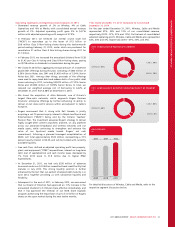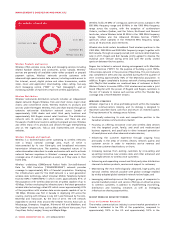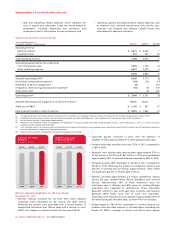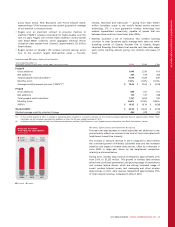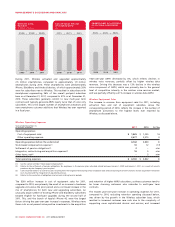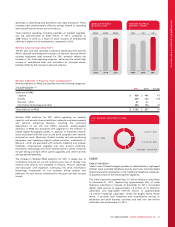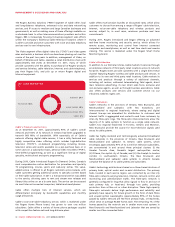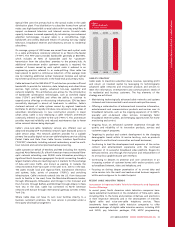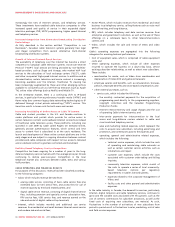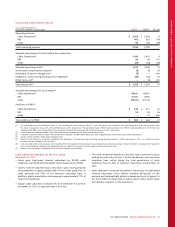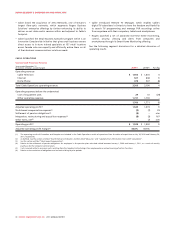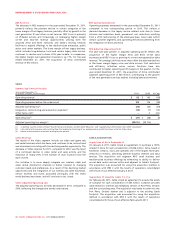Rogers 2011 Annual Report Download - page 37
Download and view the complete annual report
Please find page 37 of the 2011 Rogers annual report below. You can navigate through the pages in the report by either clicking on the pages listed below, or by using the keyword search tool below to find specific information within the annual report.
MANAGEMENT’S DISCUSSION AND ANALYSIS
Optical fibre joins the primary hub to the optical nodes in the cable
distribution plant. Final distribution to subscriber homes from optical
nodes uses high-bandwidth co-axial cable with two-way amplifiers to
support on-demand television and Internet service. Co-axial cable
capacity has been increased repeatedly by introducing more advanced
amplifier technologies. Co-axial cable is a cost-effective, high-
bandwidth and widely deployed means of carrying two-way digital
television, broadband Internet and telephony services to residential
subscribers.
On average, groups of 430 homes are served from each optical node
in a cable architecture commonly referred to as fibre-to-the-feeder
(“FTTF”). The FTTF plant provides bandwidth generally at 860 MHz,
which includes 37 MHz of bandwidth used for “upstream”
transmission from the subscribers’ premises to the primary hub. As
additional downstream and/or upstream capacity is required, the
number of homes served by each optical node is reduced in an
engineering practice referred to as node-splitting. Fibre cable has
been placed to permit a continuous reduction of the average node
size by installing additional optical transceiver modules and optical
transmitters and return receivers in the head-ends and primary hubs.
Cable believes that the 860 MHz FTTF architecture provides sufficient
bandwidth to provide for television, data, telephony and other future
services, high picture quality, advanced two-way capability and
network reliability. This architecture also allows for the introduction
of bandwidth optimization technologies, such as switched digital
video (“SDV”) and MPEG4, and offers the ability to continue to
expand service offerings on the existing infrastructure. SDV has been
successfully deployed in almost all head-ends. In addition, Cable’s
clustered network of cable systems served by regional head-ends
facilitates its ability to rapidly introduce new services to large areas of
subscribers simultaneously. In new construction projects in major
urban areas, Cable is now deploying a cable network architecture
commonly referred to as fibre-to-the-curb (“FTTC”). This architecture
provides improved reliability and reduced maintenance due to fewer
active network devices being deployed.
Cable’s voice-over-cable telephony services are offered over an
advanced broadband IP multimedia network layer deployed across its
cable service areas. This network platform provides for a scalable
primary line quality digital voice-over-cable telephony service utilizing
Packet Cable and Data Over Cable Service Interface Specification
(“DOCSIS”) standards, including network redundancy as well as multi-
hour network and customer premises backup powering.
Cable operates on behalf of Wireless and RBS (including the recently
acquired Atria Networks LP), a North American transcontinental fibre-
optic network extending over 38,000 route kilometres providing a
significant North American geographic footprint connecting Canada’s
largest markets while also reaching key U.S. markets for the exchange
of data and voice traffic, also known as peering. In Canada, the
network extends from Vancouver in the west to St. John’s in the east.
The assets include local and regional fibre, transmission electronics
and systems, hubs, points of presence (“POPs”), and switching
infrastructure. Cable’s network extends into the U.S. from Vancouver
south to Seattle in the west, from the Manitoba-Minnesota border,
through Minneapolis, Milwaukee and Chicago in the mid-west and
from Toronto through Buffalo and Montreal through Albany to New
York City in the east. Cable has connected its North American
network with Europe through international gateway switches in New
York City.
Where Cable does not have its own local facilities directly to a
business customer’s premises, the local service is provided under a
third party wholesale arrangement.
(In millions of dollars)
CABLE
TOTAL REVENUE
$3,948 $3,785 $3,796
2009 20102011
CABLE’S STRATEGY
Cable seeks to maximize subscriber share, revenue, operating profit
and return on invested capital by leveraging its technologically
advanced cable networks and innovative products and services to
meet the information, entertainment and communications needs of
its residential and business customers. The key elements of the
strategy are as follows:
• Maintaining technologically advanced cable networks and systems
clustered and interconnected in and around metropolitan areas;
• Offering a wide selection of advanced and innovative information,
entertainment and communications products and services over its
broadband networks, such as the ongoing expansion of its HDTV,
specialty and on-demand video services, increasingly faster
broadband Internet speeds, and emerging opportunities for home
monitoring and control;
• Ongoing focus on enhanced customer experience through the
quality and reliability of its innovative products, services and
customer support programs;
• Targeting its product and content development to the changing
demographic trends within its service territory, such as products
targeted to multicultural communities and small businesses;
• Continuing to lead the development and expansion of the online
content and entertainment experience with the continued
expansion of its successful broadband video platform, Rogers On
Demand Online, and through the evolution and enhancement of
its set top box capabilities and user interface;
• Continuing to deepen its presence and core connections in an
increasing number of customer homes with anchor products such
as broadband Internet, video and telephony; and
• Focusing on driving deeper penetration of its on-net data and
voice services into the small and medium-sized business segments
within and contiguous to its cable footprint.
RECENT CABLE INDUSTRY TRENDS
Investment in Improved Cable Television Networks and Expanded
Service Offerings
In recent years, North American cable television companies have
made substantial investments in the installation of fibre-optic cable,
including fibre to the home and premises initiatives, and electronics
in their respective networks and in the development of Internet,
digital cable and voice-over-cable telephony services. These
investments have enabled cable television companies to offer
expanded packages of digital cable television services, including VOD
and SVOD, pay television packages, PVR, HDTV programming,
2011 ANNUAL REPORT ROGERS COMMUNICATIONS INC. 33


